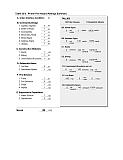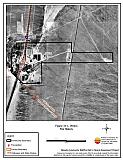33.0 Primm
33.1 Risk and Hazard Assessment
Primm is located in southern Clark County on the California/Nevada border along Interstate 15, approximately forty miles south of Las Vegas. The community hazard assessment resulted in classifying Primm in the Low Hazard category (28 points). The rating is primarily attributed to sparse vegetation and sufficient defensible space. A summary of the conditions that contributed to the hazard rating for Primm is included in Table 33-3 at the end of this section. The Primm community boundary is shown in Figure 33-1.
33.1.1 Community Design
The area surrounding the Primm community is a classic wildland-urban interface condition, with a clear line of demarcation between building structures and wildland fuels. Wildland vegetation typically does not continue into the development areas. All homes are on lots of less than one acre in size.
- Access: The primary access to Primm is Interstate 15. The road grade is less than five percent. There is adequate turnaround space for fire suppression equipment to maneuver in the community.
- Signage: There are no secondary streets with signs or houses. Clear and visible street signs and residential addresses are important in locating homes during low visibility conditions that may occur during a wildfire. Currently, the residences in Primm are situated in such a manner that there would be little chance of fire suppression personnel being unable to locate a particular structure that needed protection even under the low visibility conditions. However, if the development becomes fully built out, the need for address and street signs will be very important.
- Utilities: Utilities in Primm pose a low ignition risk.
33.1.2 Construction Materials
All structures in the interface are built with non-combustible roofing materials and have fire resistant siding materials.
None of the structures in the community have unenclosed balconies, porches, decks or other architectural features that create drafts and provide areas where sparks and embers can be trapped, smolder, ignite, and rapidly spread fire to the home.
33.1.3 Defensible Space
All structures in Primm meet the defensible space landscaping requirements to minimize damage to the home or property loss during a wildfire.
33.1.4 Suppression Capabilities
Wildfire Protection Resources
There is no fire department in Primm. The closest resources to respond to a wildland fire threatening the community would come from Clark County Fire Department Station 78 in Goodsprings, approximately thirty miles to the north. Wildfire suppression resources that would respond to a reported wildland fire near Primm are listed in Table 33-1.
| Type of Resource | Amount of Equipment | Cooperating Partner (Resource Location) |
|---|---|---|
| Water Tender Type 6 Quick Attack Engine Intermediate Life Support (ILS) Rescue |
1 1 1 |
Clark County Rural Fire Station 78 (Goodsprings) |
| Type 1 Structure Engine ALS/ILS Rescue Ladder Truck Battalion Chief |
2 1 1 1 |
Clark County Rural Fire (Nearest available) |
| Type 3 Brush Engine Type 6 Brush Patrol Engine |
1 1 |
US Forest Service (Nearest available) |
| Source: Steve McClintock, pers. comm. April 2004. | ||
Mutual aid can be requested from the US Forest Service, the National Park Service, and the Bureau of Land Management through the Las Vegas Interagency Communications Center. The Nevada Division of Forestry also provides mutual aid dispatched from the Sierra Front Interagency Dispatch Center in Minden, Nevada, which locates the nearest available fire suppression resource according to incident command and computer aided dispatch protocols. It is important to note that these resources can be assigned to other emergency incidents during the fire season.
Water Sources and Infrastructure
Water available for fire suppression in Primm includes fire hydrants with a minimum flow capacity of 500 gpm, within 500 feet of structures community wells that operate on electric pumps (with emergency back-up), and a one-million gallon storage tank.
Fire Protection Personnel Qualifications
The firefighters have a minimum of NFPA Firefighter I and II training and a limited number of volunteer firefighters have some have wildland firefighting training (National Wildfire Coordinating Group 310-1).
Detection and Communication
Wildland fires are reported by calls to 911. The Las Vegas Fire Alarm Office and local dispatch relay fires to local fire departments.
Community Preparedness
Clark County has an active Local Emergency Planning Committee and has adopted an all-risk, multi-agency emergency plan. The plan is reviewed annually and updated as needed.
The Clark County Fire Department reviews development plans to ensure compliance with the VFC 1997 fire code.
33.1.5 Factors Affecting Fire Behavior
The community is situated in a very rocky mountainous area with all aspects and sparse fuels. The vegetative fuel density in the Primm area is generally light dominated by widely spaced creosote bush, Joshua trees, and yucca.
33.1.6 Fire Behavior Worst-case Scenario
The worst-case scenario would occur on an August afternoon with an ignition along Interstate 15 south of town. Strong wind could push a fire through sparse vegetation. There is low fire danger with very low probability of structure loss if minimum defensible space is maintained.
33.1.7 Ignition Risk Assessment
Primm has a low wildfire ignition risk potential. There is no significant wildfire history in the area surrounding the community, and the recorded history of lightning strikes and other ignitions shows only one incident.
33.2 Risk and Hazard Reduction Recommendations
33.2.1 Fuel Reduction Treatments
Union Pacific Railroad
- Maintain clearance within the railroad right of way. Clear and maintain free of vegetation a minimum space of fifteen feet on either side of the railroad. The goal of this recommendation is to reduce the ignition risk along the railroad.
33.2.2 Defensible Space Treatments
Defensible space treatments are an essential first line of defense for residential structures. The goal of the treatments is to significantly reduce or remove flammable vegetation within a prescribed distance from structures. (Refer to Appendix E for the recommended defensible space area). Defensible space reduces the fire intensity and improves firefighter and homeowner chances for successfully defending a structure against oncoming wildfire.
Property Owners
- Continue to maintain defensible space around all structures.
33.3 Summary of Recommendations
| Involved Party | Recommended Treatment | Recommendation Description |
|---|---|---|
| Union Pacific Rail Road | Fuels Reduction | Maintain a fifteen foot clearance on both sides of the railroad tracks. |
| Property Owners | Defensible Space | Continue to maintain defensible space around structures. |
Table 33-3. Primm Wildfire Hazard Rating Summary |
 |
Figure 33-1 Primm Fire History |
 |
